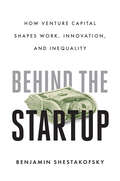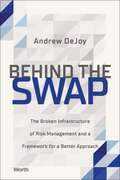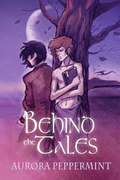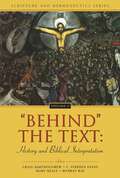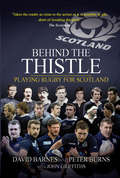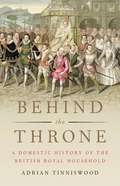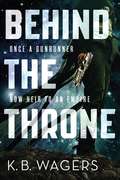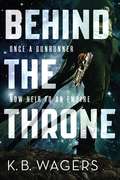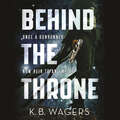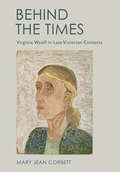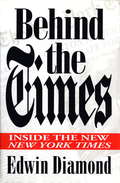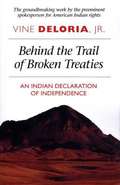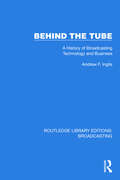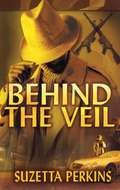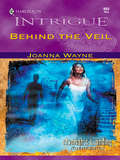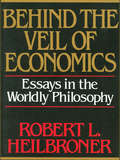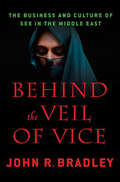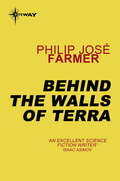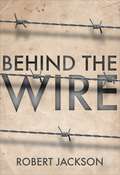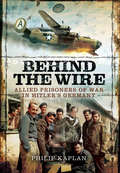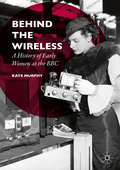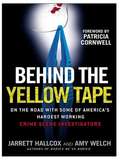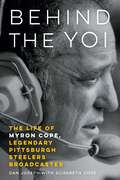- Table View
- List View
Behind the Startup: How Venture Capital Shapes Work, Innovation, and Inequality
by Benjamin ShestakofskyThis systematic analysis of everyday life inside a tech startup dissects the logic of venture capital and its consequences for entrepreneurs, workers, and societies. In recent years, dreams about our technological future have soured as digital platforms have undermined privacy, eroded labor rights, and weakened democratic discourse. In light of the negative consequences of innovation, some blame harmful algorithms or greedy CEOs. Behind the Startup focuses instead on the role of capital and the influence of financiers. Drawing on nineteen months of participant-observation research inside a successful Silicon Valley startup, this book examines how the company was organized to meet the needs of the venture capital investors who funded it. Investors push startups to scale as quickly as possible to inflate the value of their asset. Benjamin Shestakofsky shows how these demands create organizational problems that managers solve by combining high-tech systems with low-wage human labor. With its focus on the financialization of innovation, Behind the Startup explains how the gains generated by these companies are funneled into the pockets of a small cadre of elite investors and entrepreneurs. To promote innovation that benefits the many rather than the few, Shestakofsky compellingly argues that we must focus less on fixing the technology and more on changing the financial infrastructure that supports it.
Behind the Swap: The Broken Infrastructure of Risk Management and a Framework for a Better Approach
by Andrew DeJoyAndrew DeJoy&’s Behind the Swap examines the risks involved in post-trade processing in swaps and derivative markets, and provides solutions to better control those risks. While Andrew doesn&’t claim to have all the answers, he does believe there is a way to create a safer, stronger, and better financial system for all stakeholders. In August of 2020, Citibank made one of the worst mistakes in banking history: it accidently sent out almost $900 million of its own funds. Many of the recipients didn&’t give back the money. Citibank sued. And a federal court ruled that the recipients could keep the funds. Citibank&’s error is not surprising. The underlying contributors that led to the mistaken payment permeate the global financial services industry. Manual data entry, decades old technological infrastructure, inadequate training, and systems that can&’t interact with one another are just a few of the problems that face post-trade processing—the machinery behind financial markets. Unfortunately, years of neglect by regulators and financial institutions themselves has left this infrastructure needlessly complex, astoundingly inefficient, frequently inaccurate, and woefully inadequate for modern financial markets. Behind the Swap helps explain what&’s driving the recent series of banking blunders like Barclay&’s $678 million clerical error, and Citibank&’s fat-finger Flash Crash that caused an 8% decline in the Swedish stock market. The book also touches on concepts that readily connect to Credit Suisse&’s $5.5 billion loss on its trades with Archegos. The problems are easy to see but difficult to admit. For financial institutions, the current system costs billions of dollars each year in labor, systems maintenance, and lost funds. For regulators, the current system precludes the ability to track systemic risk. It also artificially inflates the stability of the global financial system. For lawyers and prosecutors, the current system allows ample opportunity for unlawful misconduct such as rogue trading and fraud.
Behind the Tales (The Knowledge Effect #2)
by Aurora PeppermintThe Knowledge Effect: Book TwoMartus understands the desire to forget the past. After all, until recently he stole to support his makeshift family. His boyfriend, Hal, has a history of losing control over his dragon transformations and causing destruction neither of them likes thinking about, and even his little sister, Elsaben, is struggling to harness her magickal gifts. But personal issues must be pushed aside when Martus’s wealthy patron hires their group to find her son, the legendary hero Fitzy. Is he in trouble or just sick and tired of the burden of fame? Perhaps his estranged sister, Mel, can help them track him down. An already difficult mission becomes an uphill battle when their demons refuse to be ignored. Even Mel is keeping secrets, and all of them are about to discover that forgetting the past won’t stop it from catching up at the worst possible time.
'Behind' the Text: History and Biblical Interpretation (Scripture and Hermeneutics Series)
by Mary Healy C. Stephen Evans Craig Bartholomew Murray Rae Robin ParryChristianity believes in a God who acts in history. The Bible tells us the story of God’s actions in Israel, culminating in the ministry of Jesus of Nazareth and the spreading of the gospel from Jerusalem to Rome. The issue of history is thus unavoidable when it comes to reading the Bible. Volume 4 of the Scripture and Hermeneutics Series looks at how history has dominated biblical studies under the guise of historical criticism. This book explores ways in which different views of history influence interpretation. It considers the implications of a theology of history for biblical exegesis, and in several case studies it relates these insights to particular texts. “Few topics are more central to the task of biblical interpretation than history, and few books open up the subject in so illuminating and thought-provoking a manner as this splendid collection of essays and responses.” Hugh Williamson, Regius Professor of Hebrew, University of Oxford, England “. . . breaks new ground in its interdisciplinary examination of the methodology, presuppositions, practices and purposes of biblical hermeneutics, with a special emphasis on the relation of faith and history.” Eleonore Stump, Robert J. Henle Professor of Philosophy, Saint Louis University, United States “This volume holds great promise for the full-fledged academic recovery of the Bible as Scripture. It embodies an unusual combination of world-class scholarship, historic Christian orthodoxy, bold challenges to conventional wisdom, and the launching of fresh new ideas.” Al Wolters, Professor of Religion and Theology, Redeemer University College, Ontario, Canada “The essays presented here respect the need and fruitfulness of a critical historiography while beginning the much-needed process of correcting the philosophical tenets underlying much modern and postmodern biblical research. The result is a book that mediates a faith understanding, both theoretical and practical, of how to read the Bible authentically as a Christian today.” Francis Martin, Chair, Catholic-Jewish Theological Studies, John Paul II Cultural Center, Washington, D.C. Not only is history central to the biblical story, but from a Christian perspective history revolves around Jesus Christ. All roads of human activity before Christ lead up to him, and all roads after Christ connect with him. A concern with history and God’s action in it is a central characteristic of the Bible. The Bible furnishes us with an account of God's interactions with people and with the nation of Israel that stretches down the timeline from creation to the early church. It tells us of real men, women, and children, real circumstances and events, real cultures, places, languages, and worldviews. And it shows us God at work in human affairs, revealing his character and heart through his activities. “Behind” the Text examines the correlation between history and the Bible. For the scholar, student, and informed reader of the Bible, this volume highlights the importance of history for biblical interpretation, and looks at how history has and should influence interpretation.
Behind the Thistle: Playing Rugby for Scotland (Behind the Jersey Series)
by David Barnes Peter Burns John GriffithsA rugby history based on exclusive interviews that &“takes the reader as close to the action as it is possible to get, short of invading the pitch&” (The Scotsman). Based on exclusive interviews with players past and present, Behind the Thistle gives a unique insight into the drama and emotion of representing Scotland in that most rarefied of environments—Test match rugby. Drawing on firsthand interviews from a vast array of former and current players, from Russell Bruce and Frank Coutts in the 1940s all the way through to the present day, the authors uncover the heart and soul of Scottish rugby, recounting the ecstasy of victory and the despair of defeat, drawing out innumerable humorous anecdotes and heartwarming memories.Behind the Thistle provides inside access to the private moments in the changing and team rooms, on tour, and on the pitch itself. From the tension before kick-off to the tumultuous heat-of-battle and the high jinks thereafter, this is the story of what it is like to play for Scotland, and the sacrifices and joys experienced by those who have shed blood, sweat, and tears in pursuit of glory in the international jersey. Absorbing, illuminating, and compelling, this is a must-have for all supporters who have dreamed of playing for Scotland. &“Really good reminiscences from hosts of Scottish rugby greats about a host of great Scotland rugby occasions.&” —Sunday Times
Behind the Throne: A Domestic History of the British Royal Household
by Adrian TinniswoodAn upstairs/downstairs history of the British royal court, from the Middle Ages to the reign of Queen Elizabeth II Monarchs: they're just like us. They entertain their friends and eat and worry about money. Henry VIII tripped over his dogs. George II threw his son out of the house. James I had to cut back on the alcohol bills. In Behind the Throne, historian Adrian Tinniswood uncovers the reality of five centuries of life at the English court, taking the reader on a remarkable journey from one Queen Elizabeth to another and exploring life as it was lived by clerks and courtiers and clowns and crowned heads: the power struggles and petty rivalries, the tension between duty and desire, the practicalities of cooking dinner for thousands and of ensuring the king always won when he played a game of tennis. A masterful and witty social history of five centuries of royal life, Behind the Throne offers a grand tour of England's grandest households.
Behind the Throne (The Indranan War #1)
by K. B. Wagers"Excellent SF adventure debut." -- Publishers Weekly, starred review Hail Bristol has made a name for herself in the galaxy for everything except what she was born to do: rule the Indranan Empire. When she is dragged back to her home planet to take her rightful place as the only remaining heir, she finds that trading her ship for a palace is her most dangerous move yet. The Indranan WarBehind the ThroneAfter the Crown
Behind the Throne: The Indranan War, Book 1 (The Indranan War #1)
by K. B. WagersMeet Hail: Captain. Gunrunner. Fugitive.Quick, sarcastic, and lethal, Hailimi Bristol doesn't suffer fools gladly. She has made a name for herself in the galaxy for everything except what she was born to do: rule the Indranan Empire. That is, until two Trackers drag her back to her home planet to take her rightful place as the only remaining heir. But trading her ship for a palace has more dangers than Hail could have anticipated. Caught in a web of plots and assassination attempts, Hail can't do the one thing she did twenty years ago: run away. She'll have to figure out who murdered her sisters if she wants to survive.A gun smuggler inherits the throne in this Star Wars-style science fiction adventure from debut author K. B. Wagers. Full of action-packed space opera exploits and courtly conspiracy - not to mention an all-out galactic war - Behind the Throne will please fans of James S. A Corey, Becky Chambers and Lois McMaster Bujold, or anyone who wonders what would happen if a rogue like Han Solo were handed the keys to an empire . . .
Behind the Throne: The Indranan War, Book 1 (The Indranan War #3)
by K. B. WagersMeet Hail: Captain. Gunrunner. Fugitive.Quick, sarcastic, and lethal, Hailimi Bristol doesn't suffer fools gladly. She has made a name for herself in the galaxy for everything except what she was born to do: rule the Indranan Empire. That is, until two Trackers drag her back to her home planet to take her rightful place as the only remaining heir. But trading her ship for a palace has more dangers than Hail could have anticipated. Caught in a web of plots and assassination attempts, Hail can't do the one thing she did twenty years ago: run away. She'll have to figure out who murdered her sisters if she wants to survive.A gun smuggler inherits the throne in this Star Wars-style science fiction adventure from debut author K. B. Wagers. Full of action-packed space opera exploits and courtly conspiracy - not to mention an all-out galactic war - Behind the Throne will please fans of James S. A Corey, Becky Chambers and Lois McMaster Bujold, or anyone who wonders what would happen if a rogue like Han Solo were handed the keys to an empire . . .
Behind the Times: Virginia Woolf in Late-Victorian Contexts
by Mary Jean CorbettVirginia Woolf, throughout her career as a novelist and critic, deliberately framed herself as a modern writer invested in literary tradition but not bound to its conventions; engaged with politics but not a propagandist; a woman of letters but not a "lady novelist." As a result, Woolf ignored or disparaged most of the women writers of her parents' generation, leading feminist critics to position her primarily as a forward-thinking modernist who rejected a stultifying Victorian past. In Behind the Times, Mary Jean Corbett finds that Woolf did not dismiss this history as much as she boldly rewrote it.Exploring the connections between Woolf's immediate and extended family and the broader contexts of late-Victorian literary and political culture, Corbett emphasizes the ongoing significance of the previous generation's concerns and controversies to Woolf's considerable achievements. Behind the Times rereads and revises Woolf's creative works, politics, and criticism in relation to women writers including the New Woman novelist Sarah Grand, the novelist and playwright, Lucy Clifford; the novelist and anti-suffragist, Mary Augusta Ward. It explores Woolf's attitudes to late-Victorian women's philanthropy, the social purity movement, and women's suffrage. Closely tracking the ways in which Woolf both followed and departed from these predecessors, Corbett complicates Woolf's identity as a modernist, her navigation of the literary marketplace, her ambivalence about literary professionalism and the mixing of art and politics, and the emergence of feminism as a persistent concern of her work.
Behind the Times: Inside the New New York Times
by Edwin DiamondAn incisive examination of the world's most respected paper, Behind the Times tells the story of changing Timesian values and of a new era for the paper--a tale of editorial struggles, star columnists and critics, institutional self-importance, and the political and cultural favorites of the Times' owners and editors. Taking the reader inside the Times' newsrooms and executive offices, Diamond offers an expert, insider's appraisal of how the Times and its editors continue to shape coverage of major public events for over one million readers. Diamond goes behind the scenes to recount the paper's recent and much heralded plan to win larger audiences and hold on to its dominant position in the new media landscape of celebrity journalism and hundred-channel television.
Behind the Trail of Broken Treaties: An Indian Declaration of Independence
by Vine Deloria Jr.Originally published in 1974, just as the Wounded Knee occupation was coming to an end, Behind the Trail of Broken Treaties raises disturbing questions about the status of American Indians within the American and international political landscapes. Analyzing the history of Indian treaty relations with the United States, Vine Deloria presents population and land ownership information to support his argument that many Indian tribes have more impressive landholdings than some small members of the United Nations. Yet American Indians are not even accorded status within the UN's trust territories recognition process. A 2000 study published by the Annual Survey of International and Comparative Law recommends that the United Nations offer membership to the Iroquois, Cherokee, Navajo, and other Indian tribes. Ironically, the study also recommends that smaller tribes band together to form a confederation to seek membershipÑa suggestion nearly identical to the one the United States made to the Delaware Indians in 1778Ñand that a presidential commission explore ways to move beyond the Doctrine of Discovery, under which European nations justified their confiscation of Indian lands. Many of these ideas appear here in this book, which predates the 2000 study by twenty-six years. Thus, Behind the Trail of Broken Treaties anticipates recent events as history comes full circle, making the book imperative reading for anyone wishing to understand the background of the movement of American Indians onto the world political stage. In the quarter century since this book was written, Indian nations have taken great strides in demonstrating their claims to recognized nationhood. Together with Tribes, Treaties, and Constitutional Tribulations, by Deloria and David E. Wilkins, Behind the Trail of Broken Treaties highlights the historical events that helped bring these changes to fruition. At the conclusion of Behind the Trail of Broken Treaties, Deloria states: "The recommendations made in the Twenty Points and the justification for such a change as articulated in the book may well come to pass in our lifetime. " Now we are seeing his statement come true.
Behind the Tube: A History of Broadcasting Technology and Business (Routledge Library Editions: Broadcasting #5)
by Andrew F. InglisBehind the Tube (1990) tells the story of the unseen foundation of modern radio, TV and cable – the technology that enables programming to reach an audience. It charts the evolution of this technology in all its facets – technical, personal, economic and social. It captures the efforts, strategies, achievements and failures of prominent and unheralded figures and companies in the dynamic and competitive broadcast industry.
Behind the Veil
by Suzetta PerkinsThou shalt not steal, murder... Jefferson Myles embezzles money from the wealthy clients of his securities firm to fund "Operation Stingray," an organization that steals ammunition from military bases to sell to rebels in Honduras. His greed doesn't stop at the bank, though. Nor covet thy neighbor's wife. His beautiful neighbor Linda, with her silky skin and curvaceous hips? Yeah, she's his too. Until her husband, Blake, discovers his secrets -- and winds up dead. Now Jefferson's life is in danger, and the wife he turned his back on may be the only one who can save him.
Behind the Veil
by Joanna WayneSTEALTHY SEDUCTION Rumor had it that the secretive owner of the castle on the cliffs, Dr. David Bryson, had been hideously scarred in the accident that killed his fiancÉe. Now designer Becca Smith had been summoned to work in his home. Though she received mysterious warnings to stay away, nothing could keep Becca from meeting the man whose seductive voice made her burn for his touch. She was too young, too beautiful, too familiar. She awakened memories in David long buried. . . emotions that teetered on the edge of insanity. But he vowed to see Becca only from the shadows. Except when a killer attacked, David stepped from behind the veil of darkness to save the woman who was his only hope of salvation.
Behind the Veil of Economics: Essays in the Worldly Philosophy
by Robert L. Heilbroner"[These essays] are rich in argument, in clear and provocative presentation of complicated issues, and are often delightfully quotable. Behind the Veil of Economics makes instructive, disturbing, and lively reading." --Elizabeth Wolgast, New York Times Book Review What lies behind the veil of economics? Power and ideology, answers Robert Heilbroner--the power of our economic involvement in society to shape the ways we think about it; the visions and values that add unsuspected ideological color to our economic beliefs about it. Most important, Heilbroner shows why economics has become the reigning form of social inquiry and how we might penetrate its mystique.
Behind the Veil of Vice: The Business and Culture of Sex in the Middle East
by John R. BradleyThe Middle East has long been something of a mystery to Westerners, and in particular, the sexual mores of the region continue to fascinate. Arabs are often described as being in a state of Islam-induced sexual anxiety and young Muslims' frustrations are said to be exacerbated by increasing exposure to the licentiousness of the West. Here, Middle East expert John R. Bradley sets out to uncover the truth about sex in countries like Egypt, Syria, Morocco and Yemen. Among many startling revelations, Bradley reports on how "temporary" Islamic marriages allow for illicit sex in the theocracies of Iran and Saudi Arabia; "child brides" that are sold off to older Arab men according to ancient tribal traditions; the hypocrisy that undermines publicized crackdowns on the thriving sex industry in the Persian Gulf; and how, despite widespread denial, homosexuality is still deeply ingrained in the region's social fabric. Richly detailed and nuanced, Behind the Veil of Vice sheds light on a taboo subject and unravels widely held myths about the region. In the process, Bradley also delivers an important message about our own society's contradictions.
Behind the Wall: My Brother, My Family and Hatred in East Germany
by Ines GeipelGermany, like many countries, has witnessed the rise of extremist far-right groups and parties in recent years, and no more so than in the eastern regions. Why have those parts of Germany that used to be part of the old GDR turned out to be so supportive of extremist groups and parties and such fertile ground for violence and hatred? To try to find answers to this question, Ines Geipel, the former East German Olympic athlete, returns to her past in order explore the matrix of fear and anxiety that shaped the lives of people in the GDR. Spurred on by conversations at the bedside of her brother as he lay dying of a brain tumour, she probes into her own family background and discovers a web of secrets and denial that reflected larger processes of East German society. She finds that her father had worked as a special agent for the Stasi until the service had no further use for him, and her grandfather had joined the Nazi party in 1933 and was stationed in Riga at a time when tens of thousands of Jews were murdered in the nearby forests. Silence and denial within her family was mirrored in the collective loss of history outside her home, and the repression of ideological non-conformity made it difficult for a traumatized population to grapple with and come to terms with a brutal past. Instead, a politics of forgetting emerged which served the ends of an authoritarian state and seeped into private lives of individuals with deep and lasting consequences. This powerful memoir, grippingly told, will appeal to anyone interested in the history of modern Germany, in the rise of far-right extremism and xenophobia and in the historical forces that shape the present.
Behind the Walls of Terra
by Philip Jose FarmerBehind the walls of Terra lay a secret no man could be allowed to learn. But Kickaha - the Earth-born adventurer of the tiered worlds - had to uncover that secret, or watch his home world destroyed.Kickaha was returning to Earth from the World of Tiers, the many-levelled universe of the god-like Lords, that he had entered many years ago as Paul Janus Finnegan. Now he had returned to a world he no longer knew, to find it ruled by Red Orc, a Lord jealous of his personal domain and hostile to intruders. Yet Kickaha had to stay alive in order to defeat the deadly enemy that threatened Earth and the other worlds of tiers - the 'Beller', the malignant creature that was the mind-essence of a rebel Lord.
Behind the White Picket Fence
by Sarah Mayorga-GalloThe link between residential segregation and racial inequality is well established, so it would seem that greater equality would prevail in integrated neighborhoods. But as Sarah Mayorga-Gallo argues, multiethnic and mixed-income neighborhoods still harbor the signs of continued, systemic racial inequalities. Drawing on deep ethnographic and other innovative research from "Creekridge Park," a pseudonymous urban community in Durham, North Carolina, Mayorga-Gallo demonstrates that the proximity of white, African American, and Latino neighbors does not ensure equity; rather, proximity and equity are in fact subject to structural-level processes of stratification. Behind the White Picket Fence shows how contemporary understandings of diversity are not necessarily rooted in equity or justice but instead can reinforce white homeowners' race and class privilege; ultimately, good intentions and a desire for diversity alone do not challenge structural racial, social, and economic disparities. This book makes a compelling case for how power and privilege are reproduced in daily interactions and calls on readers to question commonsense understandings of space and inequality in order to better understand how race functions in multiethnic America.
Behind the Wire: Prisoners of War 1914-18
by Robert JacksonA unique story of POWs in World War I. Covering traumatic capture on the battlefield, internment in POW camps, escape attempts, punishments, day-to-day boredom and meagre rations, Behind the Wire is a gripping, comprehensive history of the remarkable experiences of POWs in the First World War. Opening with the desperate scene of the brutally cold, wind-swept POW camp at Wittenburg in December 1914, where 16,000 prisoners were dying in from exposure and malnutrition, Jackson weaves together official reports and first-hand accounts to reveal the immense challenges faced by all belligerent nations in housing their prisoners of war, and how the men behind the wire did all they could to survive and one day return home.
Behind the Wire: Allied Prisoners of War in Hitler’s Germany
by Philip KaplanPhilip Kaplan presents us here with a riveting account of the Allied experience behind enemy lines, detailing the trials and tribulations experienced by the British and American airmen who were shot down in European skies during World War Two, to be incarcerated 'behind the wire' in enemy camps. With eloquence and a clear enthusiasm for the subject at hand, the author describes how various individuals adjusted to their incarceration. Whilst some set their minds resolutely on escape, and dreamt up plots and plans to achieve this end, others retreated, away from their comrades and into themselves as the grim reality of their predicament pushed them ever deeper into debilitating depression. Others were determined that they would not waste their time; affected by the quick and brutal deaths they had witnessed during their wartime careers, they were unwilling to sit idle. Theatres, recreational areas, and other camp facilities were designed and built a creative spur that made their time behind the wire, and the quality of life of their fellow comrades, infinitely more bearable. These small acts of enterprising heroism, alongside the harrowing tales of those who crumpled under the weight of their prison reality, combine to create a complete picture of this collective experience. Kaplan's skill lies in informing the reader of the facts of this history with both honesty and reverence.
Behind the Wireless: A History of Early Women at the BBC
by Kate MurphyBehind the Wireless tells the story of women at the BBC in the 1920s and 30s. Broadcasting was brand new in Britain and the BBC developed without many of the overt discriminatory practices commonplace at the time. Women were employed at all levels, except the very top, for instance as secretaries, documentary makers, advertising representatives, and librarians. Three women held Director level posts, Hilda Matheson (Director of Talks), Mary Somerville (Director of School Broadcasting), and Isa Benzie (Foreign Director). Women also produced the programmes aimed at female listeners and brought women broadcasters to the microphone. There was an ethos of equality and the chance to rise through the ranks from accounts clerk to accompanist. But lurking behind the façade of modernity were hidden inequalities in recruitment, pay, and promotion and in 1932 a marriage bar was introduced. Kate Murphy examines how and why the interwar BBC created new opportunities for women.
Behind the Yellow Tape
by Jarrett Hallcox Amy Welch Patricia CornwellFrom the authors of Bodies We've Buried-an uncensored look at real-life CSIs. With a foreword by Patricia Cornwell. For years, Jarrett Hallcox and Amy Welch trained CSIs at the National Forensic Academy in Knoxville, Tennessee. Now they provide a glimpse into the real world of crime scene investigation, and the investigators themselves. Experience, through gripping text and photographs, eight gripping accounts of true crime from across the country: from the murky waters of the Puget Sound to the crumbling ruins of the Alamo and the grimy streets of the Big Apple, these are the real stories of the people who work behind the yellow tape.
Behind the Yoi: The Life of Myron Cope, Legendary Pittsburgh Steelers Broadcaster
by Dan Joseph Elizabeth CopeMyron Cope was the color commentator for Pittsburgh Steelers radio broadcasts from 1970 to 2005, the second-longest-serving team broadcaster in NFL history. At the peak of his popularity, an estimated 50 percent of Steeler fans turned down the volume on their TVs so they could listen to the radio as Cope, in his one-of-a-kind scratchy, raspy voice, barked out phrases like &“Yoi&” and &“Okle-dokle,&” often fueled by bursts of excitability and his own beautiful brand of homerism. About his voice, Cope said, &“Mine isn&’t a broadcaster&’s voice; it tends to cut through concrete.&” Cope helped forge the unbreakable bond between the city of Pittsburgh and its football team. His evening talk show, one of the first sports talk programs in the nation, dominated its time slot for more than twenty years, and he became the first pro football announcer elected to the National Radio Hall of Fame. Born in Pittsburgh to parents of Lithuanian Jewish ancestry, Cope attended the University of Pittsburgh and became a journalist. Though he forged a successful career writing for magazines like Sports Illustrated, football fans grew to know Cope far more through the airwaves. Co-namer of the Immaculate Reception, he also created the Terrible Towel, the flag of Steelers Nation, when in 1975 he urged fans to bring gold towels to wave at a playoff game against the Baltimore Colts. Behind the scenes the Terrible Towel took on a deeper personal meaning, as Cope eventually assigned all royalties from the towels to the facility where his son, who was born with brain damage and never learned to speak, still resides. Throughout his life Cope, who passed away in 2008, raised hundreds of thousands of dollars for children with disabilities. Using Cope&’s own papers, correspondence, and tapes, plus interviews with friends and family, Dan Joseph and Elizabeth Cope, Myron&’s daughter, paint the first three-dimensional portrait of the creative, many-faceted man whom Pittsburghers still hold in high esteem and close to their hearts.
